What’s in Your Shed? visits a Herefordshire contractor
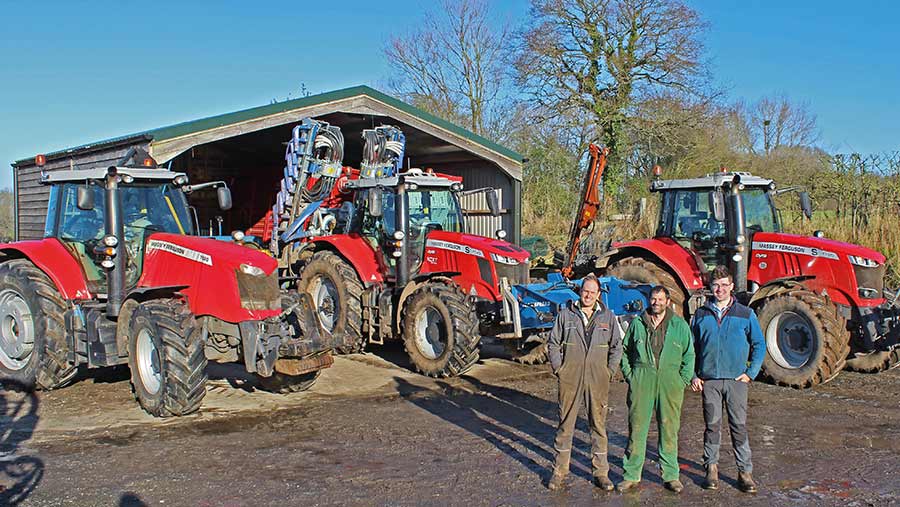 Tom Grosvenor, Martin Desborough and Toby Griffiths with their trio of Massey Ferguson tractors © James Andrews
Tom Grosvenor, Martin Desborough and Toby Griffiths with their trio of Massey Ferguson tractors © James Andrews This week’s What’s in Your Shed? delves into the machinery highs and lows of Herefordshire contractor Martin Desborough.
See also: Tips for maintaining a JCB Fastrac 2170
Business facts
- 65,000cu m of umbilical slurry and digestate pumping, plus tanker work
- 450ha of forage wagon silage
- 900hrs of hedgecutting
- Other: Fencing, groundwork
- Staff: Martin Desborough, Tom Grosvenor and Toby Griffiths plus help from another local contractor when needed
How did you get started?
I was always mad about tractors when I was a kid so, when I turned 16, I took my test and bought an International 674, which I drove everywhere.
After college, I started working for a local contractor and saved up enough cash to buy a Massey Ferguson 590 and a McConnel PA 93 hedgecutter.
That tractor was awful, but it allowed me to start doing my own contract hedgecutting alongside my full-time job.
A couple of years later I was approached by a local farmer who wanted some help farming an estate he’d taken on. This allowed me to buy a decent tractor and go out on my own.
How brand loyal are you?
I’ve always had Massey Ferguson tractors, and one of the main reasons is that I’ve had such a good dealer – JJ Farm Services near Cheltenham.
When it lost the Massey franchise and took on Kubota, I almost made the switch. The only reason I didn’t is that they don’t build a big enough tractor.
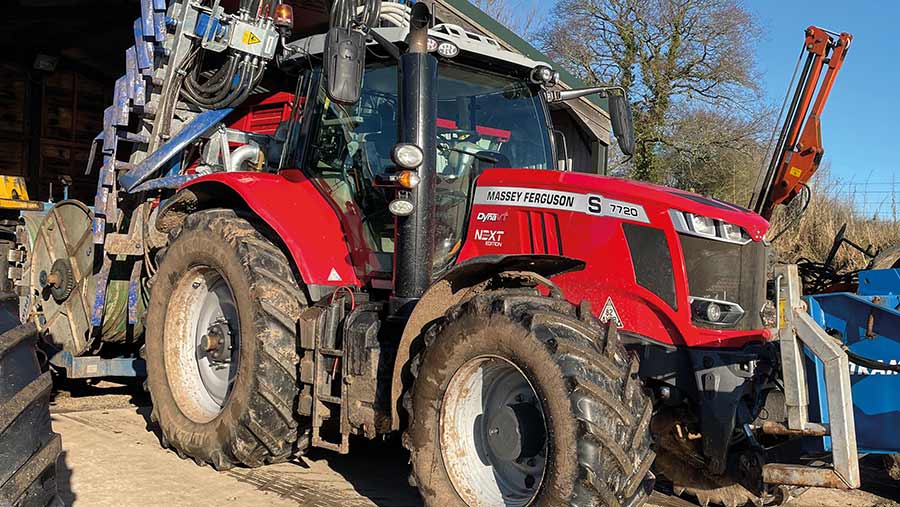
The 20-plate 7720 Next Dyna-VT carries a new 12m Tramspread dribble bar with twin Vogelsang macerators © James Andrews
Having said that, I am pleased with the 7720s we’re running now. The Sisu engines pull well, they’re nicely balanced and the stepless transmission is great to use.
They might get called a poor man’s Fendt, but I much prefer them.
As for the other machinery, I’ve settled on Tramspread for most of my umbilical kit, Lely for forage wagons (although the next one will be in Fendt colours) and McConnel for hedgecutters.
Favourite dealer?
That would be Frank Alviti, near Ludlow. He’s our local McConnel dealer and offers a fantastic service.
He and the lads there know the machines inside out and they are always on hand to get us out of trouble – nothing’s too much bother.
I get a lot of my Agco equipment from RVW Pugh now and they are good, but it’s such a shame that some of the smaller outfits have lost their franchises. I think manufacturers are being short-sighted pushing for these massive corporate dealers.
In the shed
- Tractors: 2020 Massey Ferguson 7720 Next Dyna-VT, 2018 7720S Dyna-VT and 2017 7720 Dyna-VT
- Slurry kit: Tramspread 12m and 24m twin macerator dribble bars, home-made 8m dribble bar, Tramspread front reelers x2, Tramspread pump trailer with SIL remote control, custom single-axle pump trailer made by Dave Rea Engineering, 15ft Mixit stirrer, Storth 9m Mega Mix stirrer/pump, Conor 2750 slurry tanker with 8m Slootsmid trailing shoe, 6in auto-fill and sand auger, Conor 2500 slurry tanker with brackets for 8m dribble bar and retrofit sand auger
- Grass kit: Lely MC900 triple mowers, Claas Liner 2900 twin-rotor rake, Lely Tigo PR60 forage wagon, Veenhuis VMR Combi 2000 forage wagon, Albutt 8ft front-mounted buckrake
- Hedgecutters: McConnel PA8085T VFR with 1.5m Twincut head, McConnel PA6500T EDS with 1.5m Multicut head
- Other: Parmiter post knocker, Lemken DLV 141 five-furrow plough, 3t Liebherr excavator
Favourite piece of kit?
I have a few contenders, but our McConnel 8085T hedgecutter with Twincut flail head is probably at the top.
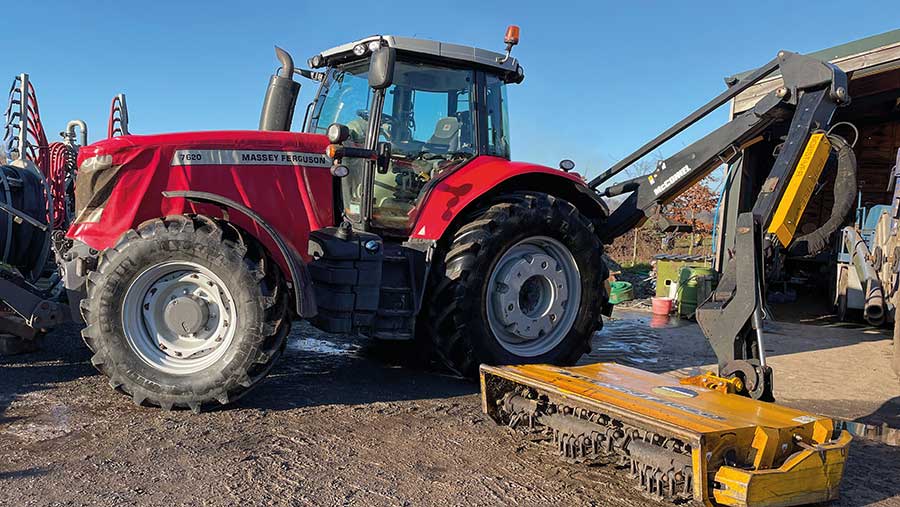
Martin Desborough runs a Massey Ferguson 7720 and McConnel 8085T hedgecutter fitted with a time-saving Twincut flail head © James Andrews
When there is one year’s growth I can cut the top of the hedge in a single pass, rather than the two I have to do with a conventional head.
But the real benefit is when I’m cutting two years’ of growth. The front rotor spins downhill to drag the material in and the rear rotates uphill to give a clean cut.
As well as letting me take off more on each pass, it mulches the debris and gives a tidy finish.
The trimmer itself is a bit larger than I’d wanted – ideally, I’d have had a 6585T – but it was the only suitable second-hand model at the time, so I went for it.
I got a friend of mine, Dave Rea, who’s a brilliant agricultural engineer, to cut the arm down by 800mm so we can tuck the head in close to the tractor for cutting up narrow lanes.
It costs more to run than a conventional trimmer and I charge my customers more as a result. However, because I get the job done quicker, their bill ends up being about the same.
Least favourite?
I like all the machines I have right now. I did have a large twin-axle NC tanker for a while which I didn’t get on with that well, but it ended up being a bit of a bargain.
Latest purchase?
I’ve just bought a 12m Tramspread dribble bar with twin Vogelsang macerators and variable geometry, which is a big step up from the fixed 8m model we were using before.
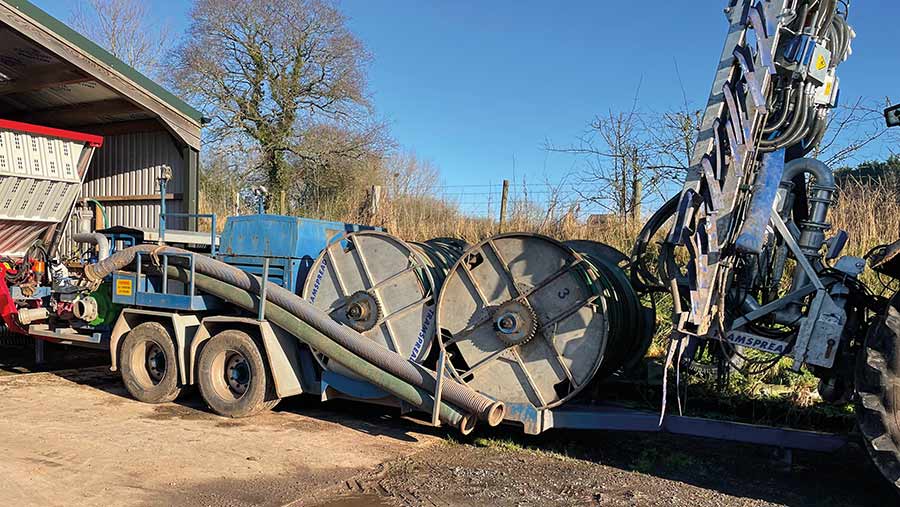
Tramspread remote pumping trailer © James Andrews
We work on some steep slopes and the adjustable geometry means we can keep the boom level and prevent overdosing on the lower side – it’s surprising how much difference it makes.
The twin macerators also give better distribution.
Oldest machine still at work?
All my fence posts are bashed in with a 2002 Parmiter knocker, which does everything I need. It has had a few modifications along the way, such as fitting a larger counterweight and adding a hydraulic leg.
How long do you keep your machines?
Generally, I’ll run tractors up to 5,000 or 6,000 hours before trading them in. You can’t get away from the fact that they cost a lot per hour to run, but this seems to be a sensible point at which to change.
I try to make every hour as profitable as possible, which is why I have machines such as the Twincut hedgecutter and Tramspread remote slurry pumping trailer.
Both save time and the trailer has the added benefit of allowing me to pump slurry on my own without putting hours on a second tractor.
Next on your wishlist?
I’d like a second Lely Tigo PR60 forage wagon to replace my 2003 Veenhuis VMR Combi.
It’s been a solid second machine, but the chop quality isn’t as good as the Lely and it’s starting to show its age.
As Lely is now owned by Agco, the new one will have to come in Fendt colours. I’ve tried asking for it with Massey branding, but they won’t have it.
Most embarrassing machinery mistake?
I was top-loading slurry from a lagoon into my old Conor 2600 tanker and the loading area had got wet from a bit of overspill.
As I pulled off, the wheels slipped over a ledge and the tanker flipped on its side, glugging its contents back into the lagoon.
Thankfully, the swivelling drawbar prevented it pulling the tractor over too. We managed to get it back on its wheels and finish the job, albeit with a hefty dent in the front of the tank.
There was a lengthy battle with the insurance company, but eventually I got a reasonable payout for it.
Most expensive repair bill?
I had a Massey Ferguson 6490 that I picked up for just £21,000 when it was on 3,800 hours.
It seemed like a bargain at the time but, not long after, the Dyna-4 transmission started giving trouble.
At first, we thought the shuttle was at fault, but when we split the tractor and got into the gearbox there were all sorts of problems.
We did a lot of the work ourselves, but the bill still ran to about £9,000. We kept the tractor for another two years and sold it on 8,000 hours, so it did redeem itself slightly.
Best invention?
I came up with an idea for adapting my 15ft Mixit lagoon stirrer so that it could be used for mixing slurry in above-ground tanks.
This involved building a frame, complete with a hydraulic powered pto and a three-point linkage, that slides onto a pair of telehandler forks.
The Mixit stirrer attaches to this and the motor is powered from the telehandler’s hydraulics.
It can get into most stores and the angle can be adjusted simply by crowding the handler’s headstock.
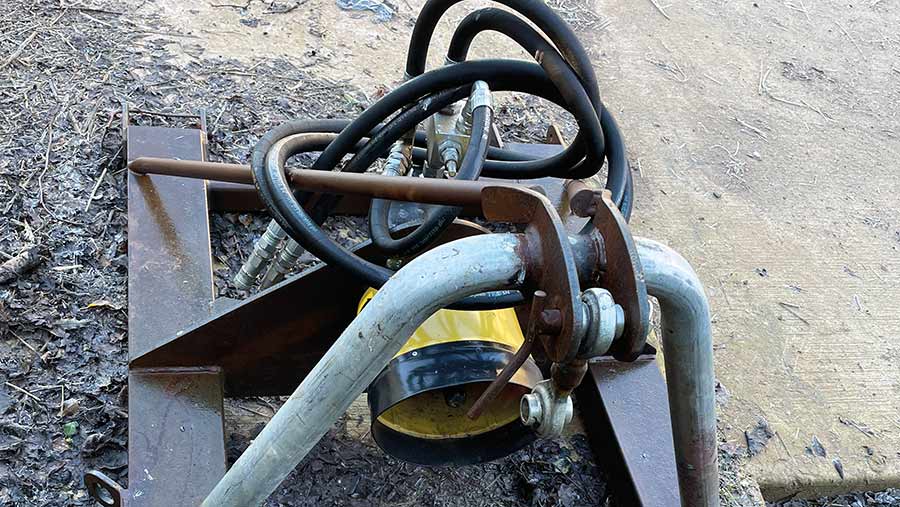
Martin Desborough’s best invention – an adapter that allows his 15ft lagoon stirrer to be used in above-ground tanks © James Andrews
It’s not as quick as a dedicated tower stirrer, but it does the job well enough. I can’t take the credit for building it – that goes to my friend, Dave Rea.
I also devised a simple way of converting a McConnel 6500T hedgecutter so that it fits on a three-point linkage.
I wanted to use it as a second trimmer so it needed to be easy to take on and off, plus I could save some cash by not having to fork out for axle brackets.
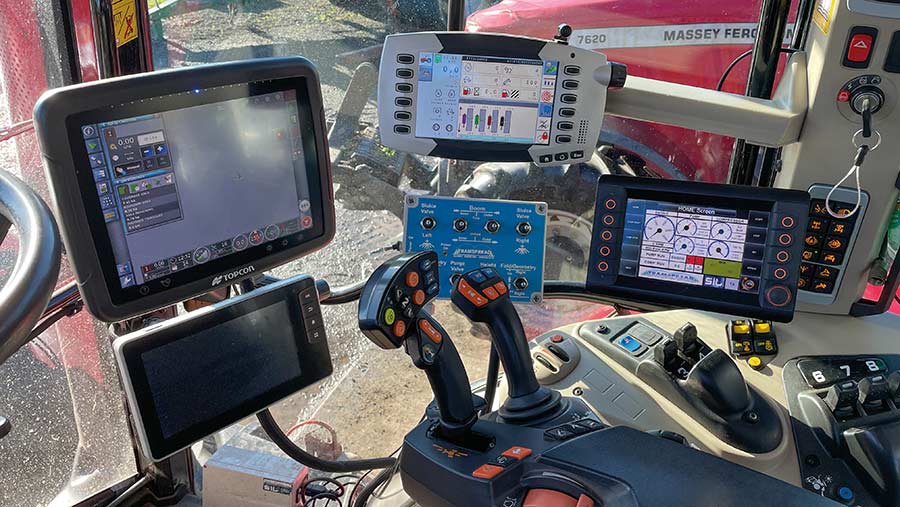
Remote slurry-pumping controls are mounted in the tractor cab, meaning one person can manage the whole job © James Andrews
What couldn’t you live without in the workshop?
I have a large twin-cylinder compressor, which we’ve plumbed around the workshop using blue water pipe. It keeps the floor area clear and it’s handy to have different points that we can connect to.
The pressure washer is also brilliant. It’s a simple hot-water model from Cleanwell, which has excellent flow and knocks muck and slurry off the equipment with ease. It’s so much better than the cheap cold-water model we had before.
Favourite and least favourite jobs?
I like all the jobs we do, but silaging with the forage wagon has the edge – it’s a great time of year and a nice change from pumping slurry.
Paperwork is my least favourite, followed by the misery of fixing a leaking slurry pipe.
What’s your everyday transport?
I’m not pickup proud, so I have a 2007 Isuzu Rodeo Denver, which is purely a workhorse.
It’s done 134,000 miles and has been reliable, but I did need to do some welding on the chassis to get it through its last MOT.
The worst thing is the amount of fuel it uses. As a result, I’m much fonder of my 1996 1.3 diesel Fiesta van, which costs next to nothing to run and never gives any trouble.
Do you buy second-hand?
It’s a bit of a mix. Of the current tractors, the 2020 7720 was new, the 18-reg was an ex-demo on 150 hours, and the 67-plate was second-hand with 1,200 hours on the clock and the remains of a five-year, 3,000-hour warranty. I do the same with implements.
Best tractor you’ve ever had?
I had a new 7480 in 2012 and it was just brilliant. It was my first CVT tractor, it had all the kit – electric spools, front linkage and pto – and I really enjoyed driving it.
It was a bit flat on the forage wagon, so I had it remapped to 181hp at the pto and it flew. I clocked up 5,500 trouble-free hours with it before selling it on.
I saw it was up for sale recently with more than 8,000 hours on the clock.
And the worst?
The old Massey Ferguson 590. It was horrible to drive, the steering was so horrendous I had to fight to keep it on the road, and it was plagued with problems.
The International 674 I had before was twice the tractor, although the noise in the cab was deafening.
Biggest machinery bargain?
I bought a 3,000gal twin-axle NC tanker with 6m dribble bar over the phone and thought I’d got a serious bit of kit. However, it was an unwieldy thing and the inside was worryingly rusty.
I ended up keeping the dribble bar and I sold the tanker for £300 less than I’d paid for it, so it didn’t turn out too badly in the end.
